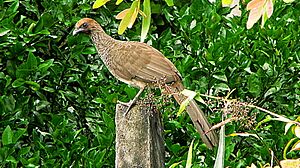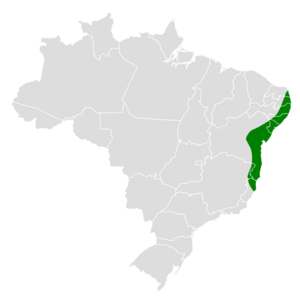East Brazilian chachalaca facts for kids
Quick facts for kids East Brazilian chachalaca |
|
|---|---|
 |
|
| Conservation status | |
| Scientific classification | |
| Genus: |
Ortalis
|
| Species: |
araucuan
|
 |
|
The East Brazilian chachalaca (Ortalis araucuan) is a cool bird that lives only in eastern Brazil. It's part of the Cracidae family. This family includes other birds like guans and curassows. Chachalacas are known for their loud calls!
Contents
About This Bird
This bird used to be thought of as a type of speckled chachalaca. But now, scientists agree it's its own special kind of chachalaca. It's also related to the little chachalaca and the buff-browed chachalaca. This bird is unique and doesn't have any different types or subspecies.
What Does It Look Like?
The East Brazilian chachalaca is about 50 centimeters (or 1.6 feet) long. It has a dull reddish-brown top of its head and neck. Its upper body is brown, and its rump (the lower back) is reddish.
Special Features
This bird has a red patch under its chin. Its lower throat and chest are dark brownish. Females have whitish spots, while males have buffy (light yellowish-brown) spots. The rest of its belly is white. Its vent (under the tail) is a yellowish-brown color. It has dark brown eyes with bare, slate-blue skin around them.
Where Does It Live?
The East Brazilian chachalaca lives in a narrow strip of eastern Brazil. You can find it from Rio Grande do Norte south to Espirito Santo and Minas Gerais.
Its Home
Its main home is the Atlantic Forest. But it also lives in other places. These include forests that have grown back after being cut down. It can also be found in caatinga (a dry shrubland) and restinga (coastal forest) areas.
How It Behaves
What It Eats
East Brazilian chachalacas often look for food in groups. These groups can have up to about seven birds. They mostly eat fruits. Scientists are still learning more about their exact diet.
How It Breeds
Not much is known about how this chachalaca breeds. One nest was found high up in a tree. It was about 3.2 meters (or 10.5 feet) off the ground. The nest was a shallow bowl made of twigs and leaves. It held three eggs.
Its Song
The East Brazilian chachalaca has a special song. It sounds like a repeated "re-a-tok." This song is easy to tell apart from the song of the speckled chachalaca. The speckled chachalaca has a five-syllable song.
Its Conservation Status
The IUCN (International Union for Conservation of Nature) checks on animals. They say the East Brazilian chachalaca is of "Least Concern." This means it's not currently in danger.
Population and Threats
Even though we don't know the exact number of these birds, they are generally common. Their population seems to be stable. They can live near people and in places changed by humans. However, they do face some challenges. These include changes to their habitat and hunting.


